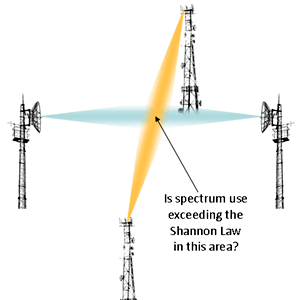DIDO, the Shannon Law, and an antenna for every citizen
A recent white paper by Steve Perlman and Antonio Forenza of Rearden (http://www.rearden.com/DIDO/DIDO_White_Paper_110727.pdf) discusses a technique they call ‘Distributed Input, Distributed Output’ or DIDO. In essence, DIDO is a form of MIMO, but which differs from MIMO in two specific ways:
- Firstly, the ‘antennas’ on the network side are intended to be placed anywhere (and everywhere), so could, for example, be replacements for your home WiFi hubs as easily as they could be positioned on towers.
- Secondly, the signal processing necessary to determine the waveform transmitted from each antenna is done centrally, rather than on a base-station by base-station basis.
The logic seems to be that, by using a central processing unit to do the complex MIMO calculations, the cost of the base stations can be reduced (because they become ‘dumb transceivers’) and further that the user equipment does not need any inherent signal processing at all, as it is all done in the network. Though the white paper is a little nebulous in some areas (there is no talk of how the connection from users to the network is managed, nor of how mobility is dealt with), the principles seem reasonable.
It is claimed that DIDO provides connectivity that exceeds the limits set by the Shannon Law (the law which determines the theoretical maximum amount of data that can be transmitted over any piece of radio spectrum), because all the spectrum can be re-used, all the time, for every user. But measured from the perspective of any user in the network, this is not the case. Each user’s connection is still bound by the restrictions enumerated in the law.

As an analogy, the same could be said for two fixed links whose paths cross. Each may achieve a service which approaches the theoretical maximum connections speed achievable, but at the point the paths overlap, the same spectrum is being used twice. So at that point, surely the spectrum is carrying twice as much data as the theory states. This is not the case, as it is the channel capacity which is bound by the law, not the capacity of the spectrum itself.
So does DIDO really do anything new? Well the idea of distributed antennas for a MIMO network is interesting, however the paper alludes to the fact that for each new user on the network, a new antenna is required. Whether the computing power required to calculate the waveforms for the sheer number of sites that would be required is feasible is a bit of an unknown. But the more interesting point hidden in the text is the need for an antenna for every user. It ‘feels’ reasonable that if every user on a network had an antenna dedicated to them, then the service that they would receive would be excellent.
But what of the cost? Is it at all economically feasible to have, say, 60 million ‘antennas’ in the UK, noting that each one is also a transceiver and needs a broadband internet connection. On the face of it, if this were a regular terrestrial mobile network, then no. But if every cordless phone, WiFi hub and other connected device were to form a DIDO network, then possibly. The point here though is not that DIDO is the solution but that having so many points of connection could offer a means of providing ubiquitous, high quality, wireless broadband. It’s already clear that to satiate the demand for data, the only realistic solution available to mobile operators is to increase the number of sites they have. Having so many would clearly solve that particular problem. If you count WiFi hubs and hotspots as cell sites, one wonders just how many points of connection there already are.
What the white paper raises, is the spectre that, if demand for data grows in the way that many are predicting, the number of wireless points of connection that will be needed may be way beyond the most frightening nightmares of current network planners!
